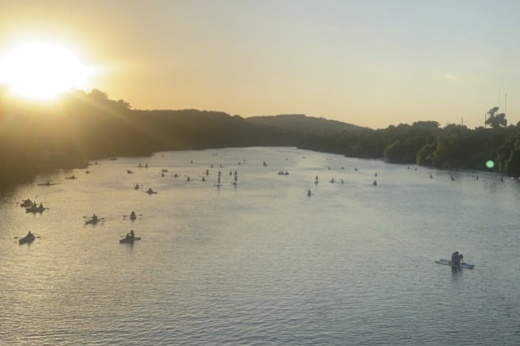The city of Austin is resuming routine monitoring as temperatures rise, with biweekly visits to three testing sites on each lake during summer through early fall, according to the news release.
When blue-green algae is present at a site, samples are taken of the algae and water and sent to be analyzed for potential toxins in a lab. These results are anticipated to be available in June and posted online.
While there are many types of blue-green algae, only some species are able to produce one of several types of toxins. If a species is capable of producing toxins, it may not necessarily do so without warm, stagnant water and nutrients, according to Watershed Protection officials.
City officials recommend avoiding contact with the algae, including not drinking directly from either lake. While swimming in Lady Bird Lake is prohibited due to a city ordinance, both Lake Austin and Lady Bird Lake continue to meet state of Texas recreational standards. These are determined by bacteria levels, according to Watershed Protection officials.
Blue-green algae is present on Lady Bird Lake & Lake Austin. Please assume algae may be toxic & avoid it. (1/2) pic.twitter.com/AnLSspVunV
— Watershed Protection (@AustinWatershed) May 16, 2023
While neither Lady Bird Lake nor Lake Austin have been found to have toxins released into the water, some species of the algae contains toxins within itself. When ingested or touched, the toxins can cause illness from the exposure in people and pets, according to the Centers for Disease Control and Prevention.
Symptoms of exposure in people include:
- Irritation of the skin, eyes, nose, throat or lungs
- Stomach pain
- Headache
- Neurological symptoms, such as dizziness or muscle weakness
- Vomiting
- Diarrhea
- Liver damage
Symptoms of exposure in pets such as dogs include:
- Excessive salivation
- Vomiting
- Staggered walking
- Difficulty breathing
- Convulsions
- Liver failure
- Death
The Watershed Protection Department began treating the area with Phoslock treatment, a lanthanum-modified clay that reduces the phosphorus available for algae growth, and will do so again in late June at Red Bud Isle and east of I-35, according to the news release. This treatment can cost up to $300,000 per year and is safe for people and the environment, according to Watershed Protection officials.
If a person has sudden, unexplainable symptoms after swimming, contact a medical provider or the Texas Poison Control Center. If a pet has sudden symptoms, contact a veterinarian.
Incidents of exposure are encouraged to be reported to watershed protection. For more information on algae, visit www.austintexas.gov/algae.





